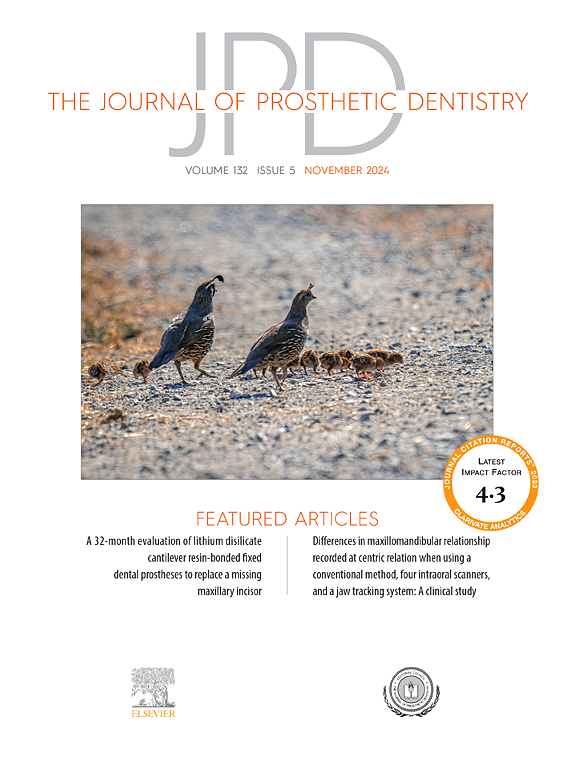Noncarious cervical lesions: Response from a 25-year clinical follow-up study
IF 4.8
2区 医学
Q1 DENTISTRY, ORAL SURGERY & MEDICINE
引用次数: 0
Abstract
Statement of problem
The etiology and diagnosis of noncarious cervical lesions (NCCLs) remain poorly understood.
Purpose
The purpose of this clinical study was to examine NCCL progression in an existing group of participants, establish the incidence of new NCCLs in a 25-year follow-up study, and relate them to possible risk factors, including occlusal factors.
Material and methods
Thirty-three participants who had completed a questionnaire about their habits, diet, and personal information were evaluated in this observational retrospective study. Impressions were made, and casts from 3 time periods (Phase I in 1996, Phase II in 1999, and Phase III in 2021) were scanned to obtain digital casts. The casts were then evaluated in a 3-dimensional analysis software program (Geomagic Control; 3D Systems) to establish digital comparisons between NCCLs and occlusal wear. Furthermore, data from an occlusal analysis device (T-Scan; Tekscan) collected in Phase I was used to analyze occlusal interferences relating to the progression of NCCLs. The statistical analysis applied nonparametric tests, followed by the assessment of the association between NCCLs and risk factors, including occlusal wear, through binary logistic regression (α=.05).
Results
At the end of Phase III, 7 new individuals with NCCLs were detected compared with Phase II. The median percentage progression of NCCLs per participant was 0.0% in Phase I, 7.1% in Phase II, and 35.7% in Phase III (P<.005). Occlusal wear in Phase I was associated with 5.02 times the occurrence of NCCLs in Phase III; occlusal wear in Phase II was associated with 4.73 times the occurrence of NCCLs in Phase III; and occlusal wear in Phase III was associated with 1.94 times the occurrence of NCCLs in Phase III (P<.001). Occlusal interference in border movements of the mandible was associated with a 3.55 times greater chance of presenting NCCLs in Phase III (P<.001). Additionally, statistically significant risk factors for the presence of NCCLs in Phase III were an acidic diet (P=.043) and alcohol consumption (P=.021).
Conclusions
The 25-year data showed an association between NCCLs and specific risk factors, including occlusal wear and occlusal interferences.
宫颈非恶性病变:25年临床随访研究的反应
问题陈述:病因和诊断的宫颈非恶性病变(ncls)仍然知之甚少。目的:本临床研究的目的是检查现有参与者组的NCCL进展情况,在25年的随访研究中确定新NCCL的发生率,并将其与可能的危险因素(包括咬合因素)联系起来。材料和方法:在这项观察性回顾性研究中,33名参与者完成了关于他们的习惯、饮食和个人信息的问卷调查。对三个时期(1996年第一阶段,1999年第二阶段,2021年第三阶段)的模型进行扫描,以获得数字模型。然后在三维分析软件程序(Geomagic Control;3D系统)建立NCCLs和咬合磨损之间的数字比较。此外,来自咬合分析设备(T-Scan;使用I期收集的Tekscan数据分析与ncls进展相关的咬合干扰。统计分析采用非参数检验,然后通过二元logistic回归评估ncls与包括咬合磨损在内的危险因素之间的关系(α= 0.05)。结果:在III期结束时,与II期相比,新检测到7例ncls患者。每个参与者的ncls进展百分比中位数在I期为0.0%,在II期为7.1%,在III期为35.7%。结论:25年的数据显示ncls与特定危险因素相关,包括咬合磨损和咬合干扰。
本文章由计算机程序翻译,如有差异,请以英文原文为准。
求助全文
约1分钟内获得全文
求助全文
来源期刊

Journal of Prosthetic Dentistry
医学-牙科与口腔外科
CiteScore
7.00
自引率
13.00%
发文量
599
审稿时长
69 days
期刊介绍:
The Journal of Prosthetic Dentistry is the leading professional journal devoted exclusively to prosthetic and restorative dentistry. The Journal is the official publication for 24 leading U.S. international prosthodontic organizations. The monthly publication features timely, original peer-reviewed articles on the newest techniques, dental materials, and research findings. The Journal serves prosthodontists and dentists in advanced practice, and features color photos that illustrate many step-by-step procedures. The Journal of Prosthetic Dentistry is included in Index Medicus and CINAHL.
 求助内容:
求助内容: 应助结果提醒方式:
应助结果提醒方式:


